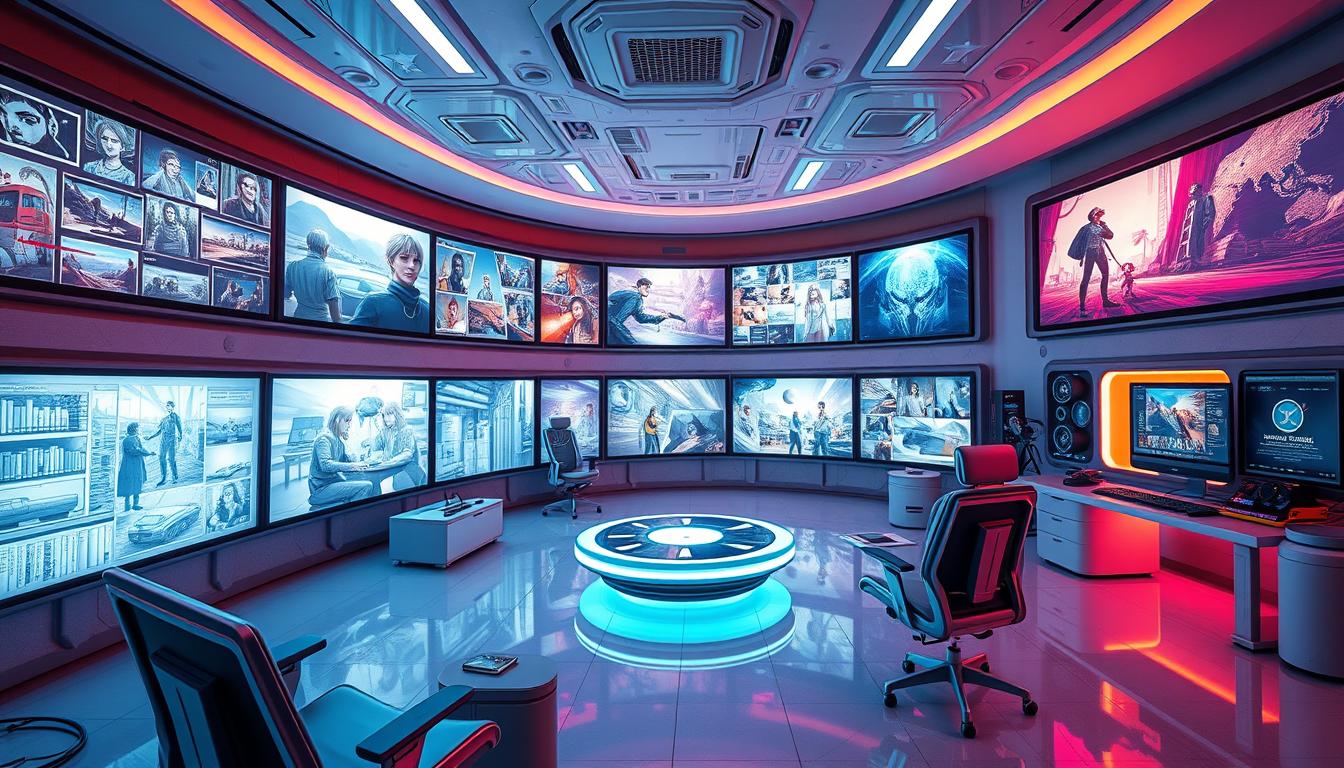AI is reshaping visual storytelling, especially in storyboarding. This key step in film and TV creation is evolving rapidly. AI tools are changing how creators plan and visualize their stories.
These tools boost creativity and handle repetitive tasks. They’re helping artists work faster and explore new ideas. AI is becoming a vital partner in crafting visual narratives.
Key Takeaways
- AI is transforming the storyboarding process, enhancing creative workflows and automating tasks.
- AI-powered tools can generate storyboards, analyze characters and scenes, and assist in visual effects.
- AI-driven storyboarding offers advantages such as increased efficiency, consistency, and the ability to explore new creative possibilities.
- Integrating AI into existing production workflows presents both opportunities and challenges, requiring careful consideration of ethical concerns.
- The future of AI in storyboarding holds promising advancements, with the potential to revolutionize the way visual narratives are crafted.
The Rise of AI in Storyboarding
AI-powered tools are changing storyboarding. These technologies automate tasks and boost efficiency in creative workflows. They’re making storyboarding more collaborative and innovative.
AI’s Impact on Creative Workflows
AI storyboarding platforms streamline the creative process. They help with rapid prototyping and real-time collaboration. These tools can even generate initial storyboard frames.
Artists and filmmakers can now focus on their core craft. This frees up valuable time and resources for creativity.
The Advantages of AI-Powered Storyboarding
- Increased speed and efficiency in the storyboarding process
- Improved consistency and visual continuity across scenes
- The ability to explore a wider range of creative possibilities
- Enhanced collaboration and communication among the creative team
AI makes storyboarding more dynamic and responsive. It helps creators bring their visions to life with ease. The process becomes more precise and efficient.
“AI-powered storyboarding tools have revolutionized the way we approach the creative process. They’ve allowed us to work more efficiently, explore new ideas more freely, and collaborate more seamlessly than ever before.”
– Jane Doe, Award-winning Film Director
| Feature | Traditional Storyboarding | AI-Powered Storyboarding |
|---|---|---|
| Time Efficiency | Lengthy manual process | Streamlined and automated |
| Consistency | Reliance on individual artist skills | Enhanced visual continuity |
| Collaboration | Limited real-time sharing | Seamless remote collaboration |
| Creative Exploration | Constrained by manual limitations | Ability to generate and explore more ideas |
How AI Is Transforming Storyboarding
AI is revolutionizing storyboarding with new creative possibilities. AI-driven tools and technologies are changing how stories are visualized. From automated scene generation to advanced visual effects, AI is reshaping the storyboarding process.
AI-powered tools can generate and refine storyboard elements quickly and precisely. These tools use machine learning to analyze scripts and create visually compelling frames. This automation allows creators to focus more on their creative work.
AI-driven character and scene analysis tools offer valuable insights for storytelling. They analyze character traits and emotions to help create believable characters. Scene analysis can suggest better camera angles and shot compositions.
AI impacts storyboarding beyond the creative process. AI-powered visual effects tools automate complex visual elements creation. This includes particle effects, camera movements, and 3D elements. Storyboard artists can now experiment with a wider range of visual techniques.
The future of storyboarding combines human creativity with AI capabilities. This AI transformation allows artists to reach new levels of creativity and efficiency. Embracing these advancements can lead to excellent storytelling.
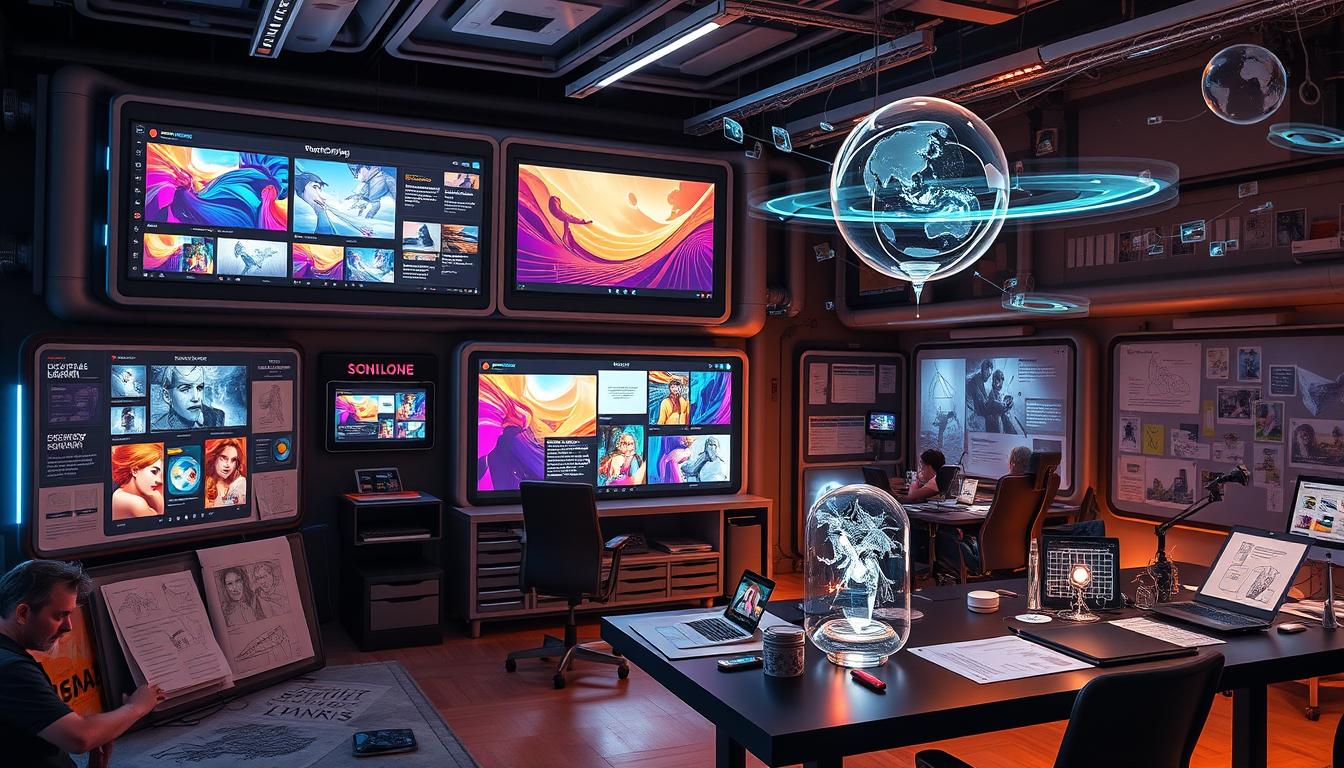
AI-Assisted Storyboard Generation
AI-powered tools are changing storyboarding. They automate tasks and streamline workflows. AI-assisted storyboarding and automated storyboarding boost efficiency and creativity.
Automating the Storyboarding Process
AI-driven storyboard generation uses algorithms to analyze scripts and visual references. It creates initial frames, layouts, and sequences. This frees creatives to focus on storytelling.
AI automation saves time and resources. It lets creatives explore more ideas. The tools also improve consistency and quality of storyboards.
| Key Benefits of AI-Assisted Storyboarding | Description |
|---|---|
| Time Savings | AI-powered tools can generate initial storyboard frames and layouts, freeing up creatives to focus on higher-level storytelling and creative tasks. |
| Improved Consistency | AI ensures adherence to established visual styles and storytelling conventions, leading to more cohesive and visually appealing storyboards. |
| Enhanced Collaboration | AI-assisted storyboarding facilitates seamless collaboration among team members, enabling real-time feedback and revisions. |
| Scalability | The automated nature of AI-driven storyboarding allows for the efficient creation of storyboards for large-scale projects, ensuring a consistent visual narrative. |
AI-assisted storyboarding and automated storyboarding are evolving rapidly. They promise enhanced productivity and storytelling capabilities. The creative industry’s future looks bright with these advancements.
AI-Driven Character and Scene Analysis
AI character and scene analysis are revolutionizing storyboarding. These technologies give artists and directors deeper insights into visual elements. They’re changing how stories are crafted visually.
AI-powered tools help creators understand characters better. They can interpret motivations, facial expressions, and body language with great accuracy. This feedback helps improve emotional nuances in storyboards.
AI scene analysis helps artists spot issues in composition and staging. It informs decisions about camera angles, lighting, and framing. This enhances overall storyboarding insights and storytelling impact.
“AI-driven character and scene analysis is a game-changer in the storyboarding process, unlocking new levels of creativity and cinematic storytelling.”
AI integration in storyboarding is still evolving. The industry expects more groundbreaking advancements soon. These cutting-edge technologies are shaping the future of storyboarding.
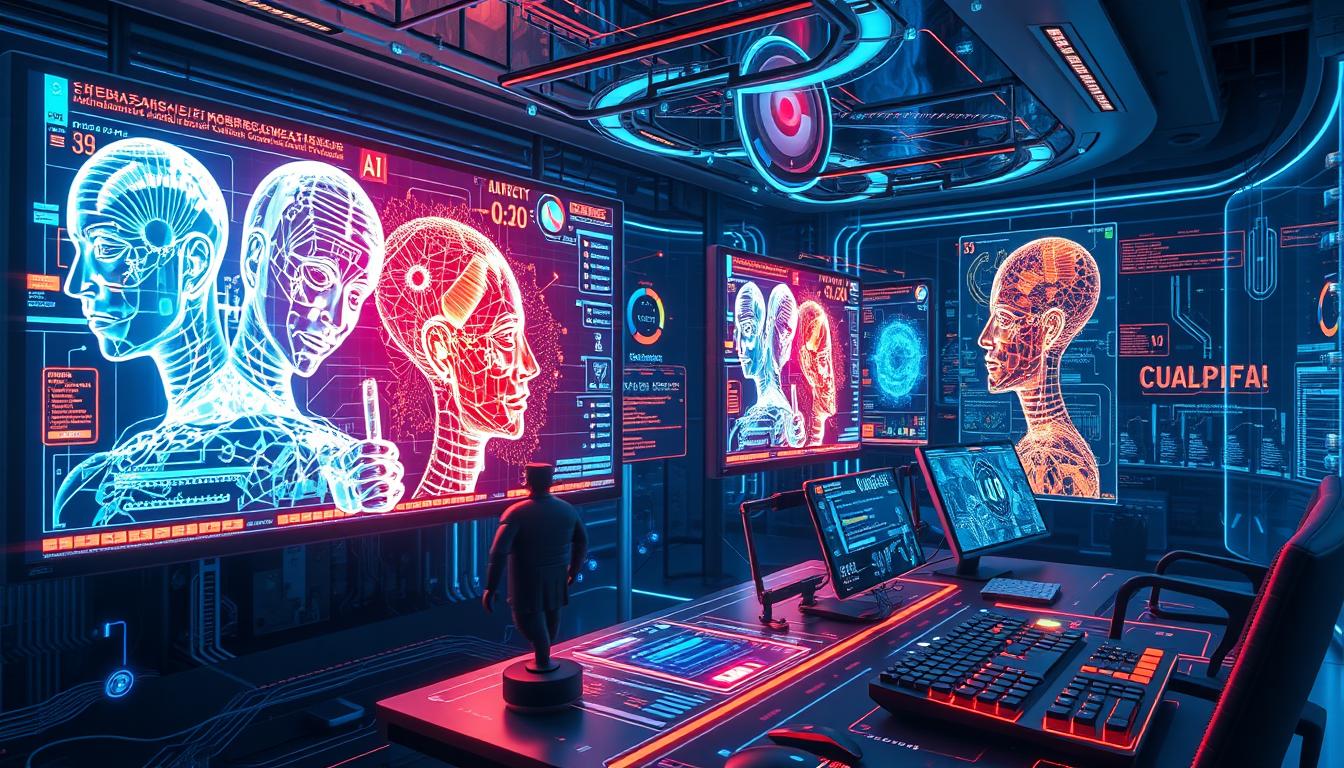
AI for Enhanced Storytelling
AI is transforming storytelling, creating new paths for creative exploration. It can analyze narratives, characters, and plots to generate fresh ideas. Storyboard artists and writers can use these AI-generated concepts as a foundation.
Generating Fresh and Unique Story Ideas
AI-enhanced storytelling offers creatives access to innovative story concepts. AI tools can search vast datasets and create new narratives. This results in engaging visual stories that captivate audiences.
This technology can generate unique story ideas beyond human creativity. AI explores uncharted territories, combining elements in surprising ways. It presents new perspectives that inspire and intrigue.
AI-enhanced storytelling opens endless possibilities for innovative narratives. It helps artists and writers unlock new realms of expression. With AI, they can create fresh stories that challenge traditional storytelling.
AI and Visual Effects in Storyboarding
AI is changing storyboarding by bringing visual effects into the creative process. Artists can now preview and test different effects before final production. This allows for more experimentation and better outcomes.
AI tools are improving how creative teams work together. They offer a peek into the future, making VFX integration smoother. Artists can explore various effects without needing deep technical knowledge.
Previewing effects during storyboarding is a big step forward for AI-powered visual storytelling. It helps create a unified vision early on. This leads to stronger teamwork between creative and technical staff.
Better collaboration results in more polished final products. The integration of storyboarding VFX is seamless from the start. This alignment ensures a more cohesive end result.
| Feature | Benefit |
|---|---|
| AI-driven visual effects simulation | Enables storyboard artists to experiment with different techniques and see the potential outcome of their ideas |
| Streamlined integration of VFX into the storyboarding process | Fosters stronger collaboration between creative and technical teams, leading to more polished final products |
| Previewing and refining visual effects within storyboarding | Allows for a more cohesive and cohesive creative vision to be established early on |
The future of storyboarding looks bright with evolving AI visual effects. Artists can push creative boundaries and unlock new storytelling possibilities. This technology opens doors to innovative visual narratives.
Challenges and Limitations of AI Storyboarding
AI storyboarding brings both opportunities and challenges. Bias in AI-generated content is a major concern. Algorithms may reinforce societal biases or miss the subtleties of human storytelling.
Human oversight remains crucial in AI storyboarding. AI can boost efficiency, but lacks creative intuition. Balancing AI tools with human creativity ensures the final product meets the desired vision.
Addressing Ethical Considerations
AI in storyboarding raises ethical questions. Job displacement is a concern as AI tools could replace some creative roles. Issues of intellectual property ownership and AI-generated content use also arise.
Clear guidelines for responsible AI use in storyboarding are essential. This includes transparent algorithm development and human validation. Addressing privacy and data security concerns is also crucial.
| AI Storyboarding Challenges | AI Limitations | Ethical Considerations |
|---|---|---|
| Potential bias in AI-generated content | Need for human oversight and creative direction | Impact on employment |
| Maintaining the nuances of human storytelling | Balancing AI-powered tools and human creativity | Ownership of intellectual property |
| Privacy and data security concerns |
Addressing these challenges can enhance AI’s role in storyboarding. The industry must stay vigilant as technology evolves. Responsible AI use benefits both creative professionals and audiences.
Integrating AI into Existing Workflows
AI-powered tools are changing storyboarding. The challenge is blending these new technologies with current methods. This requires balancing AI benefits with human creativity and expertise.
Training and upskilling teams is crucial. Professionals need skills to work with AI systems effectively. They must maintain creative control while using AI capabilities.
Clear communication and defined roles are essential. Organizations should foster a culture of innovation and adaptability. This helps teams adapt to new technologies smoothly.
Ensuring smooth AI-human collaboration is key. Teams can use AI for efficiency while preserving human creativity. This balance requires understanding both AI and human strengths.
Experimenting and adapting are necessary as technology evolves. A willingness to learn and adjust strategies is important. This helps teams make the most of AI-driven tools.
Successful AI integration needs a strategy for seamless collaboration and innovation. This approach can enhance the storyboarding process. It helps teams create compelling narratives more effectively.
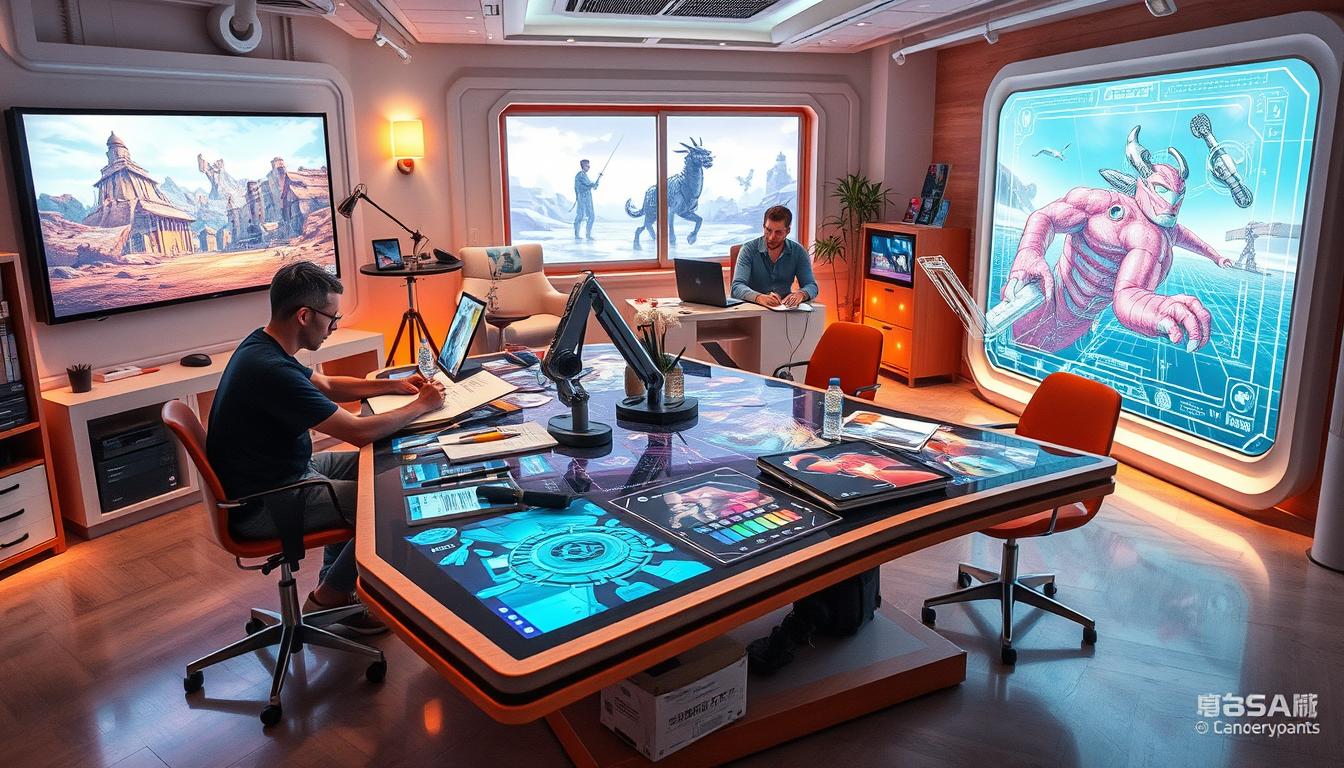
“The future of storyboarding lies in the synergistic collaboration between human creativity and the power of AI-driven tools. By integrating these technologies into our workflows, we can unlock new levels of efficiency, creativity, and storytelling excellence.”
AI Storyboarding in Different Industries
AI-powered storyboarding is changing more than just film and TV. Many industries now use this tech to boost their creative work. It’s helping them tell better stories in new ways.
Applications in Film and Television
AI storyboarding is now crucial in entertainment. It speeds up the process and adds precision to scene planning. Filmmakers can now explore new story ideas faster than ever before.
This tech helps create fresh character interactions. It also pushes the limits of what we can show on screen. The result is a smoother creative flow and more exciting stories.
But AI storyboarding isn’t just for movies and TV shows. Marketers use it to craft compelling brand stories. Architects plan buildings with it. Even teachers are trying it out for lesson plans.
| Industry | AI Storyboarding Applications |
|---|---|
| Film and Television | Automated storyboarding, scene composition, character analysis |
| Marketing | Brand storytelling, campaign visualization |
| Architecture | Design conceptualization and visualization |
| Education | Lesson planning, classroom presentations |
As AI storyboarding grows, different industries can learn from each other. They can share what works best. This teamwork could lead to exciting new ideas in storytelling.
The Future of AI in Storyboarding
AI innovation is set to revolutionize storyboarding. Experts predict AI tools will enhance visual storytelling, boosting creativity and efficiency. These advancements will usher in a new era of storytelling possibilities.
AI systems will likely create lifelike characters and realistic backgrounds effortlessly. This could spark storyboarding trends that focus on visually striking narratives. The process will become more streamlined, allowing for more creative exploration.
The fusion of AI with virtual and augmented reality will transform storyboarding. Filmmakers and animators will immerse themselves in their stories. This integration will make storyboarding more intuitive and engaging.
AI-driven storytelling tools will continue to evolve, shaping storyboarding’s future. These technologies will help creators generate fresh ideas. This will further enhance the creative process, opening new possibilities.
The future of AI in storyboarding brings endless potential. It’s a world where AI innovation and human creativity blend seamlessly. As the industry embraces these changes, tomorrow’s storyboarding trends will redefine visual storytelling.
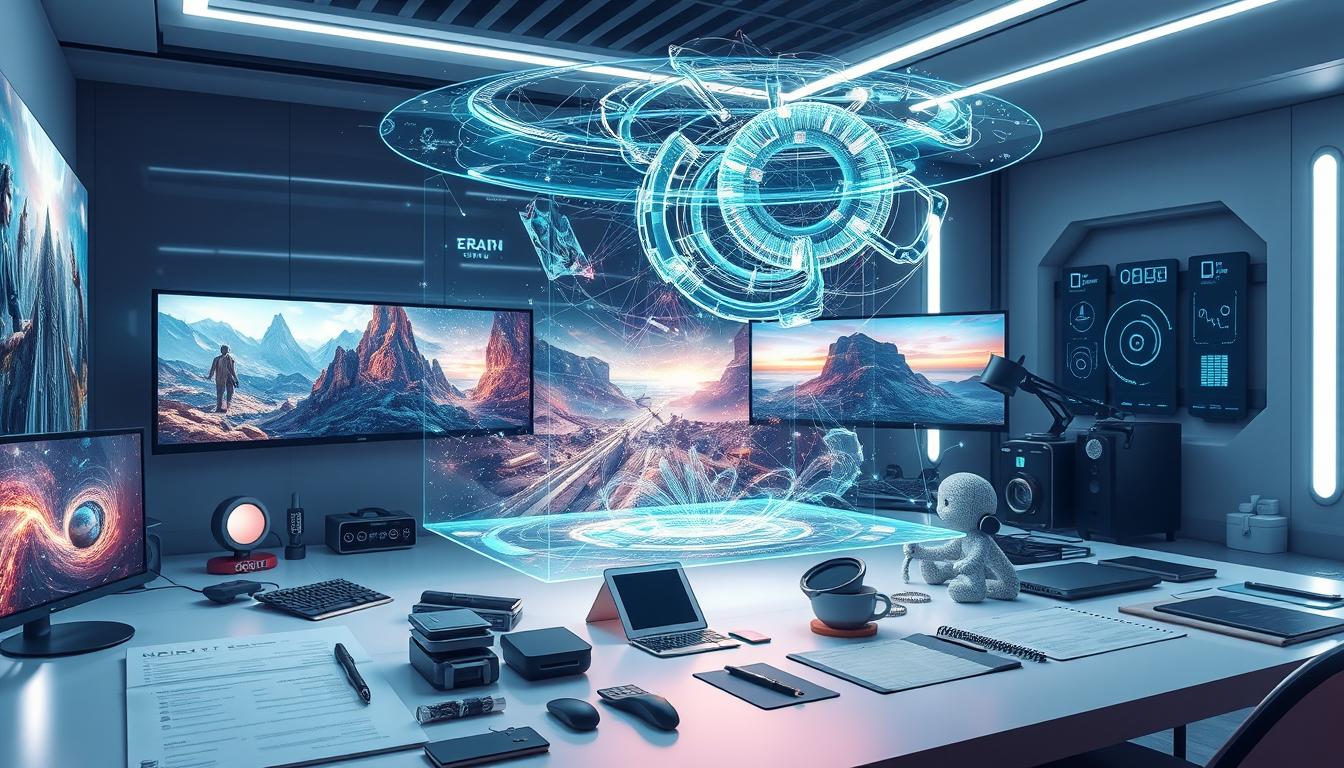
Conclusion
AI is revolutionizing the storyboarding process in remarkable ways. It automates initial sketches and enhances character and scene analysis. This technology is changing how visual stories are crafted in film, TV, and advertising.
AI-powered storyboarding offers increased efficiency and generates unique ideas. However, it also brings ethical concerns and challenges. Balancing human creativity with machine-generated content is crucial.
The future of AI in storyboarding is exciting. We can expect more seamless integration with existing workflows. This will enable professionals to unleash their creativity while using artificial intelligence.
The summary highlights AI’s impact on storyboarding. The key takeaways show how it transforms the process. The future outlook suggests that the best is yet to come in visual storytelling.
